Going Berserk
By Mento 62 Comments
Hey mangas and, uh, womangas, it's time for another slightly more in-depth article about video game influences. I had a series some years back about video games that were clearly influenced by certain iconic movie franchises, and how the evocative and terrifying H.R. Giger xenomorph of Alien or Escape From New York's grizzled hero Snake Plisskin and the ruined metropolis that was once NYC might have shown up in more than a handful of games over the years.
What I discovered with Kentaro Miura's Berserk -- a manga series I was fortunate enough to blitz through the past few weeks, since I'm struggling to find ways to fill this interminable summer of 80 degree weather and zero releases -- is that it's a lot more fun to come at something highly influential from an after-the-fact perspective. Which is to say, discovering a piece of influential media long after experiencing the media it inspired.
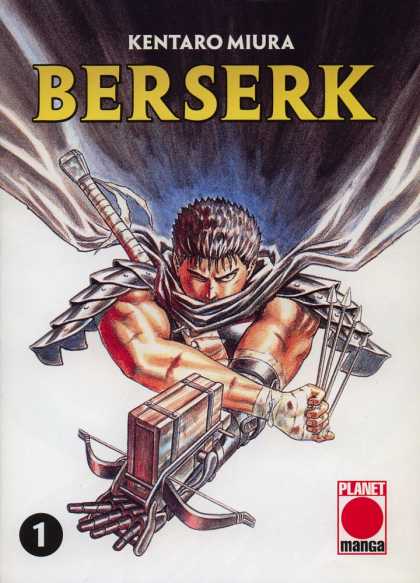
Berserk is a long-form serial manga that's been chugging along now for decades about a warrior named Guts -- so named because he was recovered as a baby from a pile of corpses on the battlefield -- attempting to rid the world of Apostles: humans that have essentially sold their souls to a demonic quintet known as the God Hand in exchange for power. The most striking aspects of Guts' quasi-European medieval world is how commonplace horrific violence and extremely grim misfortune have become, and Guts is regularly beaten to within an inch of his life by the powerful foes he engages. One of the earliest story arcs explains how he came to be this way, and its a truly heartbreaking tale involving his love interest Casca, an idealistic mercenary group known as the Band of the Hawk, and its leader Griffith, a charismatic man Guts once admired for his single-minded determination (this is also the arc that the anime adaptation was based on, which I've yet to see).
While reading through Berserk -- which began in 1990 in earnest, so it's been a presence in Japanese pop culture since the Mega Drive at least -- I started to notice many little story and world details that would later make their way into games, and how the characters themselves were familiar in an opaque way that occasionally threw me for a loop, like small jolts of deja vu. That isn't to say that the following games necessarily took a few particular cues from Berserk or that there aren't intermediary products that added extra degrees of separation, but given the manga's lasting appeal it seems very possible that it would be responsible for a similar aspect or two.
(That being said: Though my tone might sometimes come off as accusatory, there's nothing inherently plagiaristic about any of the following instances. Nothing wrong with drawing from other media for inspiration, as long as you don't overdo it.)
(A final aside: There's spoilers aplenty for the early arcs of Berserk. The nature of a serial manga is that every chapter builds from the last, and there's no real way to discuss later chapters without elaborating on earlier ones to some extent. It's also kind of impossible to talk about how a game was influenced by a certain plot point if I can't discuss the plot point in question. If you feel that strongly about spoilers, I'm cautioning you now.)
Final Fantasy VII
Now you might think the first port of call would be something like Demon's/Dark Souls, given how project lead Hidetaka Miyazaki has often cited Miura's work as an inspiration, but I shall get to that a little later. I'm starting with this one because it concerns the chief characters of Berserk, specifically the triumvirate of Guts, Casca and Griffith.
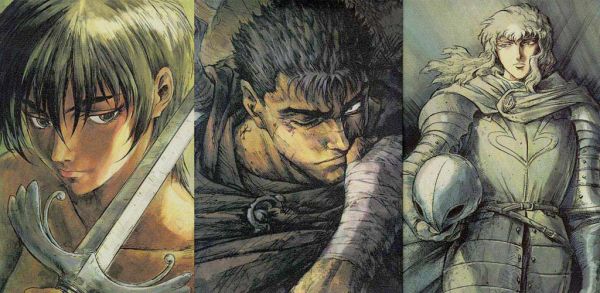
When we are first introduced to the protagonist, Guts, we get a strong sense of his taciturn and cold nature right off the bat as he's terse with some of those he meets and outright mocking of others. He's also carrying an enormous sword that no normal human being could ever hope to lift, let alone swing around, and a thousand yard stare with some obvious history behind it. The early chapters of Berserk sets up the hero and his quixotic quest to take down the demonic Apostles, many of which are powerful human nobles who become even more deadly when they transform into colossal grotesqueries, but ensures that his general mystique remains intact until we get to the Golden Age arc, which is a very long flashback that goes into the backstory of Guts.
Cutting to the chase somewhat, Guts has an eventful childhood as a soldier for hire before falling in with the Band of the Hawk, a fledgling mercenary squad already legendary for never losing a battle. Much of this is due to its charismatic leader, Griffith. Griffith is a preternaturally gifted warrior and tactician who is remarkable for two things: his long, fair hair and androgynous good looks, and his ability to command adoration or fear from everyone he meets. Guts initially joins the Hawks after being bested by Griffith in a duel, but as he continues to fight for him he truly begins to admire his talents and works hard to help him realise his dream of one day owning his own kingdom. Griffith's lieutenant Casca, the only female warrior in the Band of the Hawk, is equally devoted to Griffith and mistrustful of Guts due to his high status in Griffith's eyes. Eventually, Casca realises that Griffith only cares for his dream and that she truly loves Guts for his selflessness and caring nature. Though Griffith is on the surface an attentive and thoughtful leader, it becomes evident that he's actually a very ruthless man who regularly finds ways to exploit or dispatch his political enemies.
Though various events unfold during this long period, it ends with Griffith accepting his fate since birth to become part of the God Hand: a group of extremely powerful demonic entities, practically gods in their own right, who ask that he sacrifice the entire Band of the Hawk to the many Apostles that have gathered to witness his ascension. A handful of the Band of the Hawk are established characters at this point, and watching them all get slaughtered one after the other in a senseless and maddening ritual beyond his comprehension puts Guts somewhat at a loss. He loses his right eye and left arm trying to fight the Apostles off while Casca is brutally abused by the demons and by Griffith himself, now reborn as the demon lord Femto. Both Guts and Casca narrowly survive, though are cursed by the ritual's "brand" and are psychologically damaged beyond repair.
There's parallels aplenty to made between Berserk's and Final Fantasy VII's protagonist-deuteragonist-antagonist triangle: Cloud, right down to his absurd Buster Sword and his initial standoffish demeanor, might as well be a blond Guts (it's even lampshaded somewhat, as the man Cloud's imitating -- the dark-haired Zack Fair -- is a spitting image of Berserk's main character). Then you have Sephiroth, the white-haired, androgynous, unstoppable warrior Cloud once greatly admired before the former goes insane and kills everyone Cloud ever cared about. Tifa emerged relatively unscathed from the Nibelheim incident, unlike poor Casca who regressed to a childlike state in her PTSD, though Cloud had the displeasure of witnessing her get impaled and left for dead regardless. The tragedy of this scenario is all the more potent after reading its much rougher inspirational source, and the way the Jenova entity keeps psychologically torturing Cloud over it through his implanted Jenova cells is not entirely unlike the suffering Guts goes through due to his brand: a glyph on his neck that signifies him as part of the sacrificial ritual and draws evil spirits to him constantly. Both men are haunted by the traumatic events of their pasts, both figuratively and literally.
Final Fantasy Tactics
Final Fantasy Tactics is a game that shines largely due to its many layers. This quality applies both to the game's deeply strategic RPG gameplay as well as its frequently labyrinthine plot about a group of nobles who scheme and assassinate one another for the sake of political maneuvering and the hardworking serfs caught in the crossfire. Whenever I've seen criticisms of its plot, they usually point to the seemingly superfluous supernatural undercurrents that are secretly governing many of the game's events, to the extent that the game goes so far off the rails in its final act that you end up fighting a fake messiah deity in another dimension apropos of nothing. For some, this felt like some sort of compromise that any given Final Fantasy must have demons and monsters and supernatural crystal nonsense for it to actually count as a "Final Fantasy", and that someone higher up told the game's director Yasumi Matsuno -- one of the Japanese game development scene's finest minds as far as constructing game narratives go -- to maybe wedge in the fantasy stuff somewhere between his bickering aristocrats and heraldic warfare.
Now that I've read Berserk, it's become a little more evident to me just where all this Lucavi business actually comes from.
The setting of Berserk is, as previously stated, a quasi-European medieval setting. Prominent running themes include: the powerful and vindictive church, ruled by a host of close-minded cardinals and religious leaders ruthlessly stamping out heresy wherever they see it in an effort to maintain control of the nobles and the peasants that serve them; wars that have been raging for centuries that the comic never actually goes into too much detail about, as if to signify that they've been going on for so long and have become such an indelible part of people's lives that the reasons why and how they started are largely irrelevant, especially for the commoners conscripted or paid to fight them; the honor and nobility of knights, and how easily such virtues can become prideful and fascistic vices; and the Faustian tragedy of sacrificing one's humanity for the sake of power or wealth. These are all prominent traits of Final Fantasy Tactics as well, though I'd say all but the last one are common enough themes for any drama set in the medieval period.
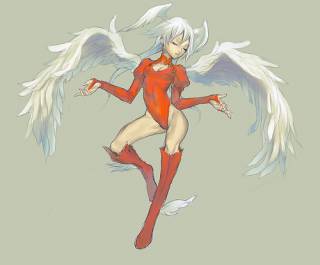
Berserk introduces the idea of the behelit: an artifact that resembles a jumbled up human face on an egg-shaped jewel that is able to create a gateway between dimensions when activated by a particularly motivated individual. Like the Lament Configuration of the Hellraiser movies, it's primarily used for summoning demons (in this case, the God Hand) and signing a pact with them in exchange for power. Due to the omnipotent nature of fate and causality, a behelit is always eventually found by someone who wishes to sacrifice everything of value to them to attain power, and this power always transforms them into an Apostle who can switch between a human form and a far uglier and stronger demonic form at will. The Zodiac Stones and the Lucavi operate almost exactly the same way, with each Zodiac Stone holder eventually acquiescing to the powerful Lucavi hidden within. Though it's the Lucavi demon in control, with each case it becomes apparent that the type of person who summoned them was also the type of person willing to do anything for the power the Lucavi wield. Invariably, every mortal that would become a Lucavi doomed themselves through their desperation and greed. Given the inclusion of Zodiac Stones and the Lucavi demons with the somewhat more historically accurate medieval trappings, it strikes me that it's more likely the case that the entire world of Ivalice was inspired by Berserk rather than the demons being some shoehorned-in afterthought compromise by a director pressured to add more "Final Fantasy type stuff" to their game's narrative. As if I needed an excuse to appreciate FFT any more than I already did.
Dark Souls
So now we move onto Souls itself. While the setting is once again a familiar case of medieval demons roaming around ruined castles and dark forests vying for what little resources are left in a world clearly on the way out, the Berserk influence is found most strongly in the art design. This is deliberate, and one of the few examples I have on this list where the creator of the series has actually gone on record to state Berserk as one of the primary influences for the game. Though there's bits and pieces in the earlier Demon's Souls, most notably the foreboding Tower of Latria as an ersatz Tower of Rebirth (an eerie and dark prison full of torture devices that held Griffith for a year), most of the Berserk references appear in the second game: Dark Souls.
It's mostly little things, those which fans of the manga are more likely to pick up on. Like how Anor Londo greatly resembles the manga's fallen royal city of Wyndham, or how some of the uglier enemies and bosses are all but Apostles lifted directly from the manga's pages, or how even those thrice-accursed bonewheels got their start in an arc of Berserk -- these are all such commonplace occurrences that it's a little redundant and time-consuming to try to list them all out. There's a number of fan videos like this one that helpfully point out the art similarities, for the curious (though some of the connections those videos come up with seem a tad tenuous).
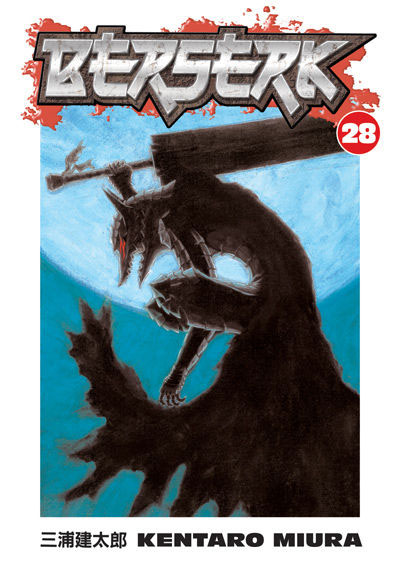
The most flagrant and most deliberate homage is Artorias the Abysswalker, who is a spitting image of Guts in his Berserker armor. The Berserker armor is an artifact given to Guts quite late into the manga's timeline, and can transform anyone who wears it into an unstoppable bestial attacker. Wearers aren't slowed down by pain or fear, and any damage they accrue is "fixed" by the armor with some brutal temporary measures. For instance, the armor will react to a broken bone by inserting spikes all around the fracture to keep the bone in place. Whenever Guts is desperate enough to rely on the armor, it's always a dramatic moment because he risks losing his humanity each time, as well as his own life. Most notable is that his fighting style completely changes -- instead of tactically planting himself and swinging his sword in wide arcs, he'll leap into the air while spinning the sword, ending with a devastating downward slash. Artorias is based on this version of Guts, from the intimidating wolf-like armor to his loss of humanity to his unorthodox fighting style. Clearly, Dark Souls's director Hidetaka Miyazaki figured it would make for an interesting fight if the player had to go up against Guts in full berserker mode, and he was right to the extent that it's often considered one of the most interesting and challenging boss fights in the game.
Borderline Examples
Before we move to the final section of this scrutiny, here's a few more games that might've taken a few leafs from Berserk's trade paperback. I'm less confident about these ones, so I'm relegating them to a quickie list. I'm sure there are others, if any fans of the manga want to help me out in the comments below.
- The Legend of Zelda: Ocarina of Time - One of the central relationships in Berserk is Guts's begrudging friendship with the fairy Puck. Puck is absolutely one of those 80s/90s comic relief sidekick buddies who flits around for little jokey asides and visual comedy, but also has an important job of keeping Guts's humanity intact. He's often his conscience in trying times, and without him the manga might well be too dark to tolerate. Since Ocarina of Time, the Zelda games have given Link his own fairy companion to guide him and speak for the silent hero whenever necessary. Navi, Tatl, Fi and others tend to be the only companions Link ever has through most of his adventuring, and while they can often be annoyingly persistent with their advice, they also make the journey far less lonely.
- God Hand - It's perhaps a coincidence, but Shinji Mikami's comedic brawler shares its name with a prominent force of evil in the Berserk comics. The hero Gene also has an artificial arm, like Guts, and much of the game's playtime is spent beating up weird looking demons (or getting beaten up by demons, in my case). The tone couldn't be more dissimilar though, I'll say that much.
- Dragon's Dogma - Borrowing from the same dark fantasy well as Dark Souls to some degree, Dragon's Dogma has a similar "cursed" protagonist in the Arisen and features a lot of similar art design for its monsters and geography. Notably, the game also includes Berserk's and Griffith's armor sets for player characters to use. Whether this is a simple tie-in on Capcom's part or a means for the game to acknowledge its influence is unclear.
- The Last Story - I mention Mistwalker's Wii RPG The Last Story because it shares a lot of narrative similarities with the aforementioned Golden Age arc of Berserk. To elaborate further would lead to too many spoilers, if simply making the comparison isn't one already, but the grim state of the world and the machinations of a small but tightly-knit mercenary group and the ungrateful nobles they serve skews decidedly close to Berserk's longest and best known arc.
The Berserk Games
Before I wind this down, I figured it was probably worth checking out two games that absolutely were inspired by Berserk. Sword of the Berserk: Guts' Rage and Berserk: Millennium Falcon Hen Seima Senki no Shou (possibly translates to Berserk: Millennium Falcon Arc: Holy Demon War Chapter, thanks to Pepsiman for helping me make sense of it) are two action games based on the Berserk license, the first for the Dreamcast and the second for the PS2.
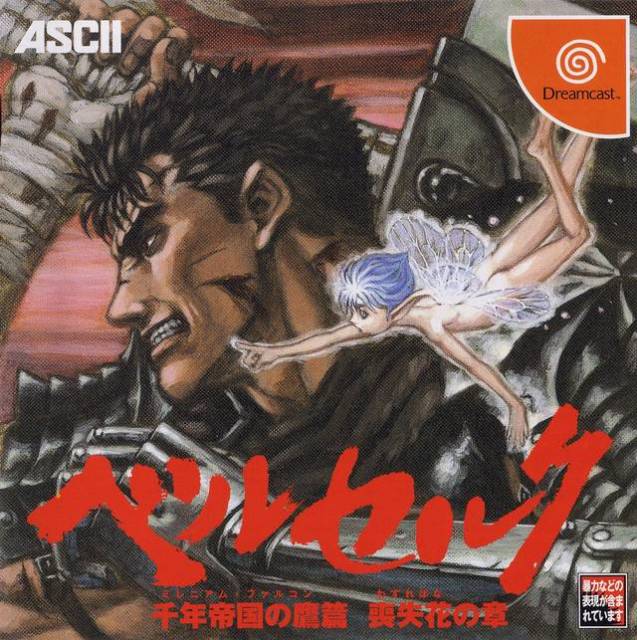
Guts' Rage actually came out in the west, surprisingly for a manga adaptation. It even has a full English voice cast and everything. It's set during the Millennium Falcon arc (nope, nothing to do with Star Wars) in which Guts is travelling around with Casca in tow, travelling to the fabled realm of the elves in order to help her restore her sanity. The game creates its own little self-contained story about a town sieged by mutated humans afflicted by the mandragora plant, which feels more like an excuse to have a lot of weird monsters roaming around for Guts to fight. Though it's largely independent from the manga, including a relatively normal audience surrogate outsider character who inquires about Guts's journey to help acclimatize those unfamiliar with the source material, there's a few fan favorite appearances: Nosferatu Zodd, a particularly strong Apostle that Guts has fought a few times who briefly shows up for the game's toughest boss fight, and the enigmatic Skull Knight, an extremely powerful entity attempting to oppose the God Hand who occasionally helps Guts out who makes a small cameo in the epilogue.
As for the type of game it is, it's one of those proto-Devil May Cry brawlers that tried to take the burgeoning character action format in its own direction before the DMC games (and God of War) all but codified the genre. While Guts has some powerful attacks, he's limited by the large size and slow speed of his main weapon: the enormous Dragonslayer blade. Often, he'll need to find a good spot to plant himself and then start swinging, and keep moving when his position is no longer tactically viable. In addition, the player can make use of a "berserk mode" which temporarily makes Guts invincible and a lot stronger, as well as Guts's various gadgets including the cannon concealed in his artificial arm, a few healing tinctures courtesy of Puck's medicinal fairy dust and the handful of throwing knives and bombs he keeps on his person. All of these additional items are in limited supply but will frequently restock after each stage, so the game all but insists that the player rely on their resourcefulness and strategic wits to determine the best time to use them. Generally speaking, the cannon's best reserved for bosses, the knives for ranged units who try to stay out of reach of Guts's melee attacks and the bombs for when Guts gets swarmed by weaker enemies. Because berserk mode fully heals Guts each time it activates, the player can often try to keep fighting to fill its gauge before they run out of health, or opt to use up one of their limited full heal items and not risk dying. Like Chaos Legion, another DMC peer/also-ran that failed to attract much attention, it's not the sort of character action game where you can wade into every enemy encounter with your sword swinging: doing so is likely to get you killed fast. It's a little more thoughtful than it would first appear, and its difficulty appears to have put a lot of people off.
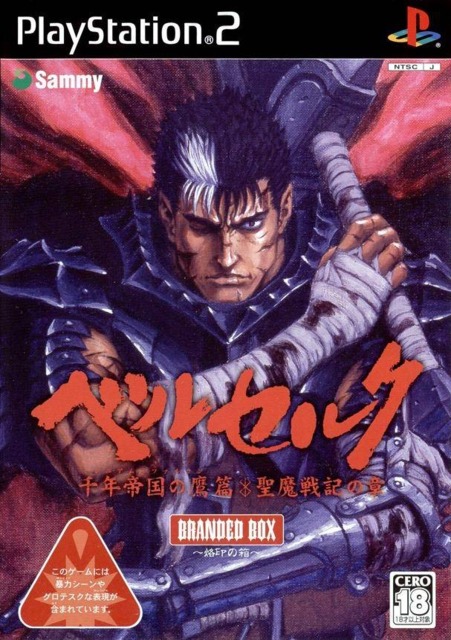
I know very little about the second game, as it was never released outside of Japan, but it appears to be a similar sort of character action game. It's set during the same arc in the manga and while it updates a lot of the mechanics, not to mention the graphics, it seems to be a similar sort of deal. Both games were created by Yuke's, perhaps best known for their wrestling games (they currently develop 2K's annualized WWE series, previously owned by THQ), so there's a characteristic amount of jankiness that brings the two games down a little, but their faithfulness to the tone of the manga is generally considered acceptable by the fanbase from what I've gathered.
Anyway, that's probably more than enough discussion on this site about "some manga thing". I don't usually spend much time discussing non-video game related material here (perhaps I should? GB's slowly becoming that kind of all-purpose site, really) but the number of times I would stop reading and think "Huh, where have I seen this before?" approached a figure that convinced me that I should try to jot all this down for an in-depth blog further down the road. Which is what this is, for the record.
As a final, final note, I would absolutely recommend Berserk to anyone, whether they're interested in the influences behind some of their favorite JRPGs or simply curious about comics with a lot of darker tones and extreme violence. It can be a tough read at times due to how oppressively grim it can get, but it has some amazing art and some really cool and weird ideas and concepts, especially with its villainous Apostles. Guts has something of a whole posse at this point in the manga, and the added number of characters with their own ongoing arcs is adding a lot to the narrative.
(All right, one more final note: Shout-outs to Matt, Pat, Woolie and Liam of the "Best Friends Play" Zaibatsu. I have no idea if those guys still visit Giant Bomb, but I wanted to thank them and their Sword of the Berserk LP for introducing me to the manga.)
